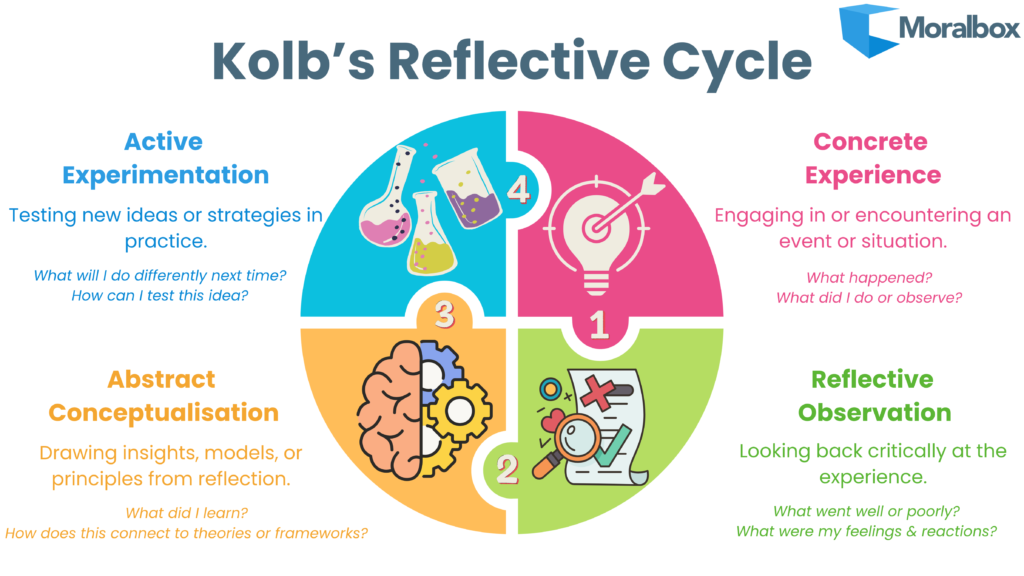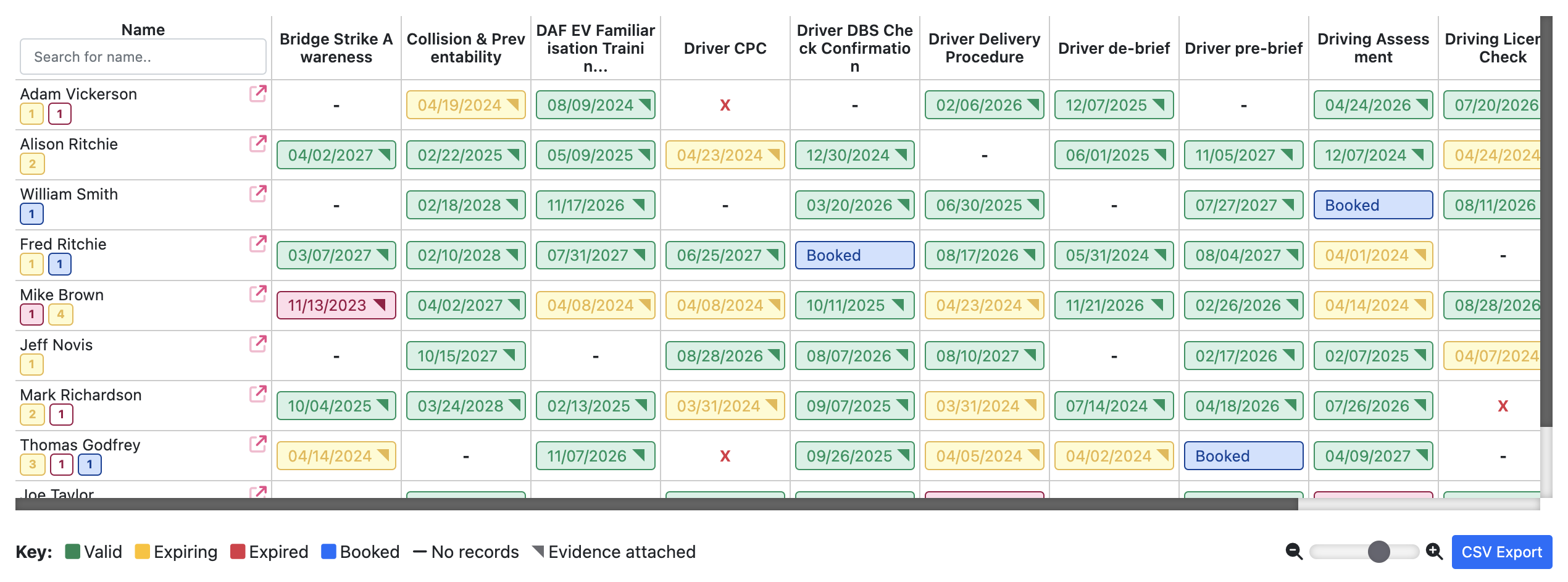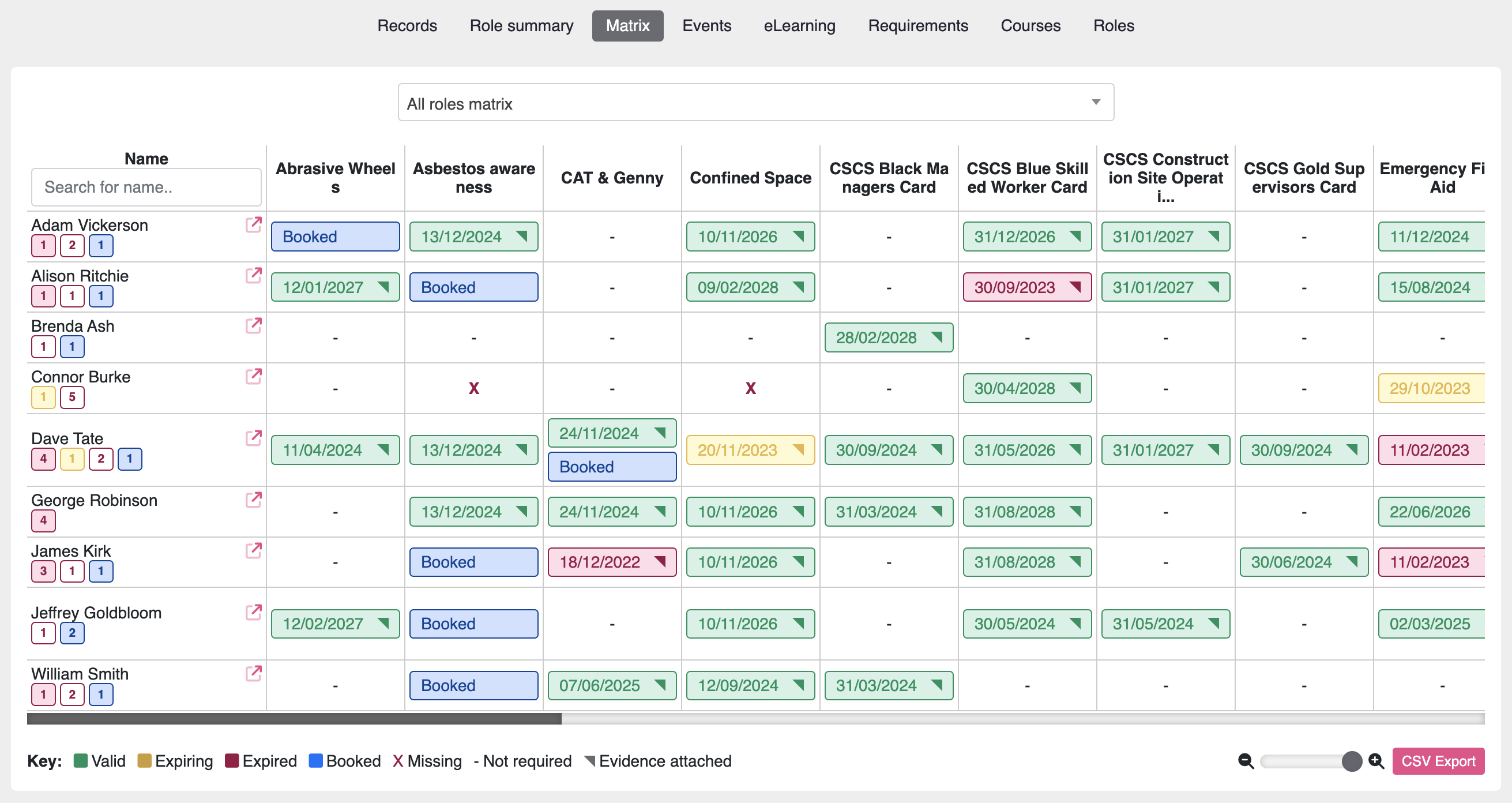Introduction: A Scenario from the Real World
Imagine a Thursday afternoon in a secondary school science lab.
During an experiment on chemical reactions, a student accidentally mixes the wrong compounds, causing minor fumes and an evacuation. The teacher manages the situation quickly, and no one is harmed. Later, following Kolb’s reflective cycle, instead of simply issuing reminders about safety, the teacher asks the class to walk through what happened, why, and how they can prevent it next time.
This reflective debrief, when structured using Kolb’s Reflective Cycle, transforms an incident into powerful experiential learning.
Now, think of this as the same process happening on a construction site, in a hospital, or within a corporate project team. That is the strength of Kolb’s model because it provides a structured loop to turn every experience into continuous improvement.
Table of Contents
- Introduction: A Scenario from the Real World
- What Is Kolb’s Reflective Cycle?
- Applying Kolb’s Reflective Cycle to Our Scenario
- Applications of Kolb’s Reflective Cycle
- Comparative Table: Kolb vs Related Reflective Theories
- Support from Recent Research
- Criticism and Limitations of Kolb’s Reflective Cycle
- Common Pitfalls and How to Avoid Them
- FAQs
- Conclusion
- References
What Is Kolb’s Reflective Cycle?
Kolb’s Reflective Cycle, also known as the Experiential Learning Cycle, explains how people learn by transforming experience into knowledge through a continuous process of reflection and action. It views learning as more than just acquiring information; it is an ongoing cycle where doing, thinking, and applying are closely connected (Kolb, 1984).
Originally developed by David A. Kolb in the early 1980s, the model was built upon the experiential learning philosophies of John Dewey, Jean Piaget, and Kurt Lewin, who each emphasised the importance of experience, reflection, and adaptation in learning. Later interpretations, such as Illeris (2018) and Egan et al. (2023), expanded Kolb’s ideas to lifelong and professional learning. Over the years, it has become a cornerstone of reflective practice in education, healthcare, and organisational development.
Kolb’s model describes four key stages that guide this process:
- Concrete Experience: engaging in or encountering an event or situation.
- Reflective Observation: reviewing and considering what happened from different perspectives.
- Abstract Conceptualisation: drawing insights, models, or principles from reflection.
- Active Experimentation: testing these new ideas or strategies in real situations.

Applying Kolb’s Reflective Cycle to Our Scenario
Let’s revisit the classroom incident and map it through the four stages:
- Concrete Experience:
The students conduct an experiment that goes wrong, triggering safety protocols. - Reflective Observation:
Together with the teacher, students reflect on how instructions were followed, what distractions occurred, and how decisions were made under pressure. - Abstract Conceptualisation:
The teacher links this to chemical safety theory, human error, and the importance of following standard operating procedures. - Active Experimentation:
The next week, the same students design their own mini-experiments with a safety checklist, testing improved teamwork and preparation.
The loop continues as new experiences lead to further reflection and refinement, turning learning into continuous action.
Thus, to make reflection more structured and practical, you can now apply Kolb’s four stages using this free downloadable template. It includes clear guiding prompts and fillable sections to help educators, trainers, or professionals document their reflections effectively.
Applications of Kolb’s Reflective Cycle
Kolb’s framework is used across education, healthcare, business, and also in the training sectors worldwide. Let’s explore the applications in more detail-
Education
- Teachers design reflective journals and post-lab discussions that explicitly guide students through the four stages.
- Research in nursing education found that a Kolb-based teaching design significantly improved self-directed learning and critical thinking (Cheng et al., 2025).
- In universities, simulation-based learning aligned to Kolb’s stages has been shown to strengthen communication, problem-solving, and teamwork (Daneshfar and Moonaghi, 2025).
Workplaces
- Corporate learning teams use the model in after-action reviews and project retrospectives to embed lessons from successes and failures.
- Some organisational case studies have reported that experiential learning programs based on Kolb’s model improved knowledge retention and adaptability across teams, though further controlled research is encouraged (Illeris, 2018).
- Leadership programs often combine field assignments (experience), reflection sessions, theory workshops, and action plans directly mirroring the four stages.
Healthcare and Other Sectors
- Nursing and medical training utilise Kolb’s learning cycle to guide debriefs after patient simulations or real-life incidents.
- Construction and engineering teams use the model for post-incident reviews, learning from near-misses to prevent recurrence.
- Customer service and sales professionals utilise the model to enhance communication and problem-solving through real-life customer scenarios.
Thus, Kolb’s model works anywhere people must learn from experience to improve performance.
Comparative Table: Kolb vs Related Reflective Theories
| Model | Core Idea | Stages / Structure | Focus Area | Best Used For |
|---|---|---|---|---|
| Kolb’s Reflective Cycle (1984) | Learning occurs through a continuous process of experiencing, reflecting, thinking, and acting. | 4 stages: Concrete Experience → Reflective Observation → Abstract Conceptualization → Active Experimentation | Experiential learning and reflection. | Designing active learning, workplace training, and professional development. |
| Gibbs’ Reflective Cycle (1988) | Expands on Kolb by adding feelings and evaluation to encourage deeper personal reflection. | 6 stages: Description → Feelings → Evaluation → Analysis → Conclusion → Action Plan | Emotional and analytical reflection. | Teachers, clinicians, leaders, and practitioners are adapting in real time. |
| Schön’s Reflective Practice (1983) | Focuses on professional reflection during and after action. | 2 modes: Reflection-in-action (during practice) and Reflection-on-action (after practice) | Professional judgment and decision-making. | Learning preferences and behaviour. |
| Honey and Mumford Learning Styles (1986) | Builds on Kolb’s model by identifying learner preferences in approaching experiences. | 4 styles: Activist → Reflector → Theorist → Pragmatist | Structured written reflections, nursing, and counselling education. | Learning preferences and behaviour. |
This comparison helps clarify that Kolb’s model is about process, while others like Honey & Mumford focus on preference, and Gibbs or Schön extend the reflective dimension.
Support from Recent Research
Over the past few years, a growing body of evidence has continued to reinforce the relevance of Kolb’s model across education, healthcare, and workplace learning contexts. Furthermore, researchers are increasingly exploring how to adapt experiential learning to modern, technology-enhanced environments.
- A 2025 study by Cheng et al. integrated Kolb’s four-stage framework into advanced nursing education through case analyses, mind maps, reflective journals, and peer simulations. As a result, students demonstrated significant improvements in self-directed learning, critical thinking, and overall satisfaction compared with traditional lecture-based methods (Cheng et al., 2025). Moreover, the authors concluded that when learners actively progress through all four stages, they internalise knowledge more deeply and retain it for a longer period. Consequently, Kolb’s approach remains highly effective in helping students bridge the gap between theory and practice.
- Daneshfar and Moonaghi (2025) reviewed simulation-based learning and found that when reflection and experimentation were systematically embedded, students achieved stronger transfer of clinical skills and better professional judgment. Consequently, Kolb’s model effectively bridges the gap between theory and practice.
- Although corporate data is less standardised, Illeris (2018) and later case studies show that experiential learning programs based on Kolb’s process can enhance adaptability, innovation, and collaboration. Consequently, Kolb’s reflective process remains a cornerstone of modern professional development.
Criticism and Limitations of Kolb’s Reflective Cycle
Although Kolb’s model continues to be widely applied, several researchers have noted important limitations and misinterpretations. However, these critiques aim not to dismiss the model but to refine how it is used in practice.
- Misuse of Learning Styles
Kolb’s framework is often associated with his Learning Style Inventory (LSI). Nevertheless, research shows limited evidence that matching instruction to specific styles improves outcomes. For example, Clinton-Lisell and Litzinger (2024) found minimal support for the learning-styles matching hypothesis, and Hattie and O’Leary (2025) concluded that learner preferences are fluid, not fixed. Therefore, educators should design diverse experiences that engage all stages of learning rather than labelling individuals. - Over-Simplification of Reflection
However, real learning is complex and iterative. Egan et al. (2023) argue that Kolb’s model should be seen as a lifelong, evolving spiral rather than a closed loop. Hence, reflection should be flexible, allowing learners to re-enter the process at any stage depending on context. - Cultural and Contextual Sensitivity
Finally, scholars note that reflection is shaped by cultural and professional norms. For example, in some collectivist cultures or hierarchical workplaces, open self-evaluation may be uncomfortable or perceived as inappropriate. Consequently, facilitators must adapt Kolb’s cycle with cultural awareness and contextual empathy. Furthermore, providing alternative reflection formats such as guided discussion, anonymous journaling, or visual mapping can make the process more inclusive.
Thus, the best approach is to use Kolb’s cycle as a flexible framework, not as a checklist.
Common Pitfalls and How to Avoid Them
Even though Kolb’s Reflective Cycle is practical and easy to understand, many educators and trainers still struggle to apply it effectively. Reflection sessions are often rushed or inconsistent, which reduces their impact. Furthermore, some misinterpret Kolb’s ideas, focusing too narrowly on learning styles or treating the model as a one-off task. By addressing these pitfalls, facilitators can make reflection more consistent, structured, and impactful.
| Pitfall | Better Practice and Why It Works |
|---|---|
| Treating reflection as optional | • Schedule reflection intentionally after each major learning event. • Use guided prompts such as “What worked well?” or “What surprised me most?” to deepen thinking. • Provide time and structure through journals, debriefs, or digital tools. As a result, reflection becomes purposeful and leads to sustained behavioural change. |
| Using learning styles to label people | • Avoid fixed labels like “Activist” or “Reflector.” • Design activities that move through all four stages. • Rotate formats to engage everyone. Consequently, this inclusive design encourages flexibility, collaboration, and deeper engagement. |
| Stopping after one loop | •Revisit reflections after implementing actions. • Plan follow-up sessions to compare before-and-after insights. • Link new experiences back to prior lessons. Therefore, learning becomes an ongoing process rather than a single event. |
| Lack of facilitator or mentor support | • Train facilitators to guide reflective discussion. • Use open-ended questions such as “What assumptions influenced your decision?” • Connect experiences to theory for real-world relevance. As a result, guided reflection builds insight, accountability, and growth. |
FAQs
Is Kolb’s cycle linear or flexible?
It is cyclical and flexible. Learners can begin at any stage, but true learning occurs when all four stages are experienced and integrated (Egan et al., 2023).
How is Kolb’s model different from Gibbs’?
Kolb focuses on the learning process itself, whereas Gibbs adds emotions and evaluations, making it more suitable for personal reflection.
Should I use learning styles from Kolb’s inventory?
No. Research shows learning style categories are unstable and weakly predictive of success (Clinton-Lisell & Litzinger, 2024; Hattie & O’Leary, 2025). Use the stages, not the labels.
Conclusion
Kolb’s Reflective Cycle remains one of the most practical and research-supported tools for turning experience into genuine learning. From classrooms and hospitals to leadership programs and project teams, its four-stage loop promotes reflection, theory building, and experimentation, the hallmarks of adaptive learning.
Thus, by embedding this cycle into everyday practice, learners cultivate habits of curiosity, analysis, and improvement. When applied flexibly and supported by thoughtful facilitation, Kolb’s model transforms ordinary experiences into opportunities for lifelong growth.
References
Cheng, J. et al. (2025) ‘Integrating Kolb’s experiential learning theory into nursing education: a four-stage intervention with case analysis, mind maps, reflective journals, and peer simulations for advanced health assessment’, Frontiers in Medicine, 12. Available at: https://doi.org/10.3389/fmed.2025.1616392.
Clinton-Lisell, V. and Litzinger, C. (2024) ‘Is it really a neuromyth? A meta-analysis of the learning styles matching hypothesis’, Frontiers in Psychology, 15. Available at: https://doi.org/10.3389/fpsyg.2024.1428732
Daneshfar, M. and Moonaghi, H.K. (2025) ‘The impact of clinical simulation on bridging the theory–practice gap in nursing education: a systematic review’, BMC Medical Education, 25(1). Available at: https://doi.org/10.1186/s12909-025-07790-8.
Egan, J. D., McBrayer, J. S., Tolman, S. and Ballesteros, E. (2023) ‘Reconceptualizing Kolb’s Learning Cycle as Episodic and Lifelong’, Experiential Learning & Teaching in Higher Education, 6(1), pp. 24–33. Available at: https://doi.org/10.46787/elthe.v6i1.3607.
Hattie, J. and O’Leary, T. (2025) ‘Learning Styles, Preferences, or Strategies? An Explanation for the Resurgence of Styles Across Many Meta-analyses’, Educational Psychology Review, 37(2). Available at: https://doi.org/10.1007/s10648-025-10002-w.
Illeris, K. (2018) Contemporary Theories of Learning: Learning Theorists… In Their Own Words, 2nd edn. Abingdon: Routledge.
Kolb, D. A. (1984) Experiential Learning: Experience as the Source of Learning and Development. Englewood Cliffs, NJ: Prentice Hall.

Ananya is a Marketing Executive at Moralbox, passionate about creating content that connects learning with business impact.


